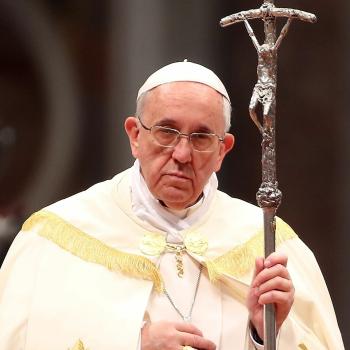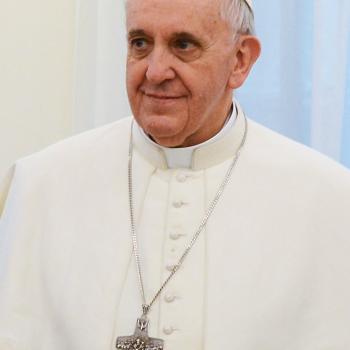
Well, it was inevitable. The baptismal love haze lifted. The rose colored glasses finally fell off.
But I’m still here. In fact, my faith is stronger than ever, not in spite of but because of being forced into battle not only with non-Catholics but also with a few Catholics, too.
Jesus started it. On purpose. I’m sure of it.
“Do you love me?” He was asking, over and over again. The way did with Peter that day, after Peter had forsaken Him three times in one night.
And like Peter, I can say, “Yes,” without hesitation. Because if I didn’t, the past two weeks would’ve ended our relationship for sure.
Some of you may already have read the heated exchange in the comments of one of my Patheos pieces, Confession Conundrum. That wasn’t much of a test. We’ve all heard those anti-Catholic arguments before, even newbies like me. They never go anywhere. They’re not meant to.
The biggest tests came from fellow Catholics. Warnings I received against reading certain authors (too New Age), visiting certain sites (dens of dissidents), even thinking certain thoughts (slippery slopes).
There were television shows, podcasts and videos for and by Catholics that stunned me with ferocious—and sometimes contradictory–denunciations and declarations on everything from politics to parenting.
One channel seems to be choosing Trump based solely on his questionable pledges of allegiance to the pro-life and pro-religious freedom movements, while ignoring his racist rhetoric and vitriolic attacks on women and almost anyone else who disagrees with his views, entirely.
A host on the same channel repeatedly reminded an African American guest that we didn’t have “all the facts” about the shootings of two African American men by policemen that week, which was true. But the relentless repetition of that assertion as his guest patiently agreed while trying to offer the insights she’d been invited to provide hurt my heart.
I’m constantly asked why there aren’t more Black Catholics. Imagine how a Black non-Catholic viewer who happened upon that exchange would answer that question.
As I reeled from all the rancor, two passages from “Amoris Laetitia” finally floated up from the depths of my memory:
“Unity of teaching and practice is certainly necessary in the Church, but this does not preclude various ways of interpreting some aspects of that teaching or drawing certain consequences from it. This will always be the case as the Spirit guides us towards the entire truth…until he leads us fully into the mystery of Christ and enables us to see all things as he does. Each country or region, moreover, can seek solutions better suited to its culture and sensitive to its traditions and local needs. For ‘cultures are in fact quite diverse and every general principle… needs to be inculturated, if it is to be respected and applied’” (p. 4) “We also need to be humble and realistic, acknowledging that at times the way we present our Christian beliefs and treat other people has helped contribute to today’s problematic situation. We need a healthy dose of self-criticism.”(p. 26)
Can I get an “Amen?”
You see, here’s the thing. For non-cradle Catholic converts, not to mention the entirely non-religious, the discourse patterns and opinions of long time Catholics can be rather…well, disconcerting. We don’t know the lingo. We didn’t grow up immersed in the Catholic world view.
So what seems “New Agey” or “fringe” to you may just seem reassuringly familiar to us. In fact, my first foray into Catholicism was an earnest attempt to complete an online retreat on the Creighton University site because it reminded me of the other religions and disciplines I knew more about. It was, therefore, more approachable, and an enticing introduction to the Faith I would finally and wholeheartedly join.
Likewise, some of our political views may seem very “worldly” and wrong-headed to Catholics, and our cultures frighteningly foreign. But when you stiffen and stifle, we feel rebuked. Disrespected. And there is no hope of conversion.
Jesus reached out to some pretty “interesting” people, even when His disciples and the Pharisees were scandalized. He even changed His mind sometimes. Gasp.
Remember the Caananite woman (Matthew 15:21) who asked Him to save her daughter? He rebuffed her with a line that still makes me wince whenever I read it.
“It is not right to take the food of the children and throw it to the dogs,” He told her, because she was not Jewish.
But she persisted, begging, “Please, Lord, for even the dogs eat the scraps that fall from the table of their masters.”
And Jesus heard her. And healed her child.
Some of us non-cradle Catholic converts, especially those who’ve had little or no other religious training, are still a bit like her. And the Samaritan woman at the well and that adulteress he saved from being stoned to death and those tax collectors and the Roman centurion who asked Him to heal his servant.
We’re from a different world, still getting acclimated to yours. Sometimes we look for something familiar from our old worlds to hold onto while we make the crossing. And sometimes Jesus tells us not to let go of those things entirely, because He thinks you need them as much as we do.
Something I always try to remember, when talking to my still very stunned friends and family, is that I am the only Catholic some of them have ever met up close and personal. But over the past few months I’ve learned that Catholicism has, even for many who have no faith at all, a kind of inherent authority that no other faith can match.
Watch non-Catholic visitors enter the nave sometime. Watch their faces, their body language. God touches them. Something softens, even as they hesitate by the font, trying to figure out what to do.
Even the least “Catholic curious” among my friends admit that Catholic churches “feel different.” One Protestant friend goes to Mass to be blessed even though he cannot accept the body and blood as we do. It “cleanses” him, renews his faith.
So they “get it” sometimes, even if they’re not ready to give in to it. And if you really want to help them take that first step, meet them where they are. Find common ground first and be patient with the ideas that set your teeth on edge.
Once someone is really ready, those scary ideas will begin to magically mesh and morph. Trust me, I know. But they may also have some ideas that fit better than you think.
Philippians 2:4 advises us to “humbly regard others as more important than yourselves, each looking out not for his own interests, but [also] everyone for those of others.”
Tall order. But we’ve got the best Teacher ever, right?
Photo credit: Angelica Kauffman [Public domain], via Wikimedia Commons
















